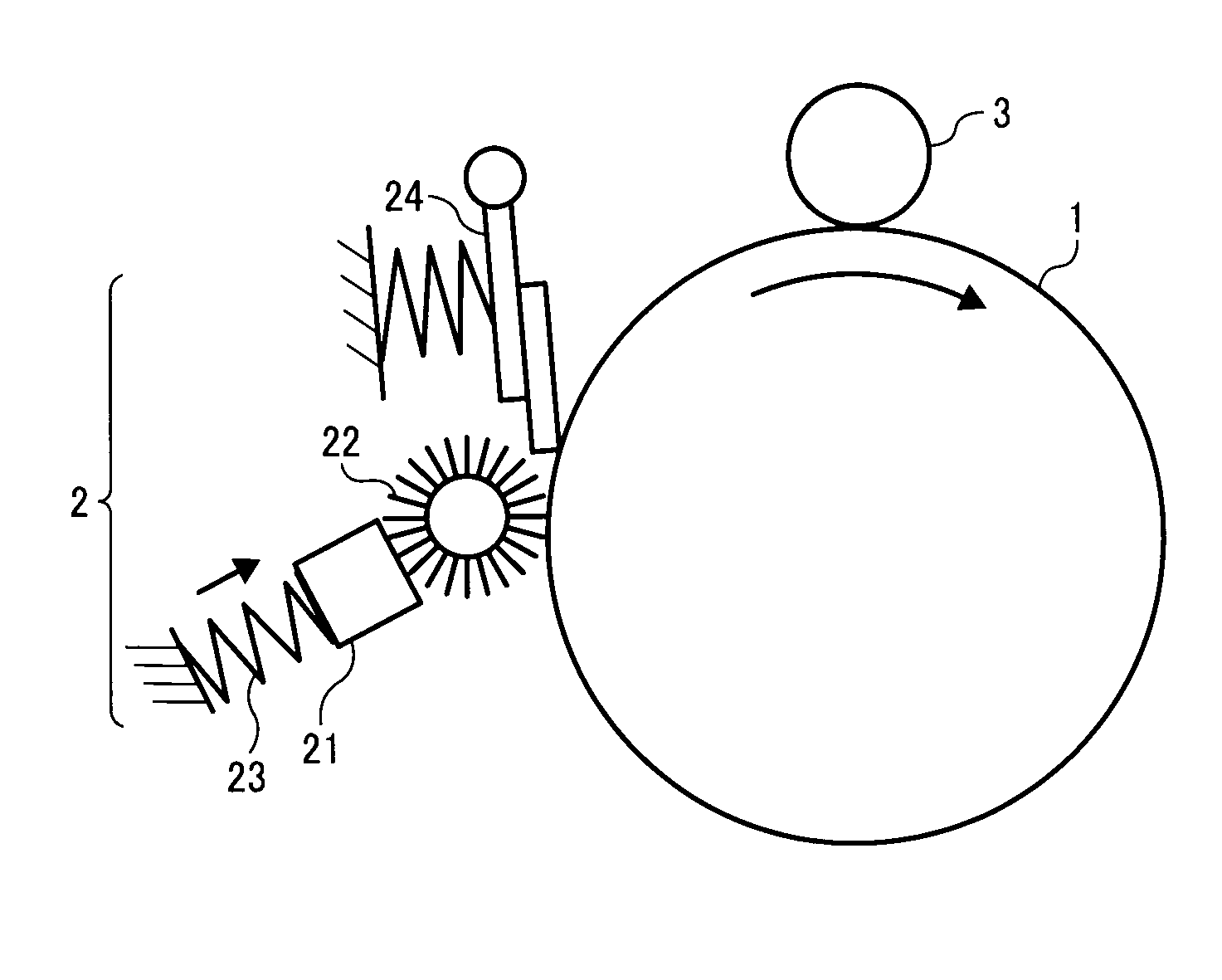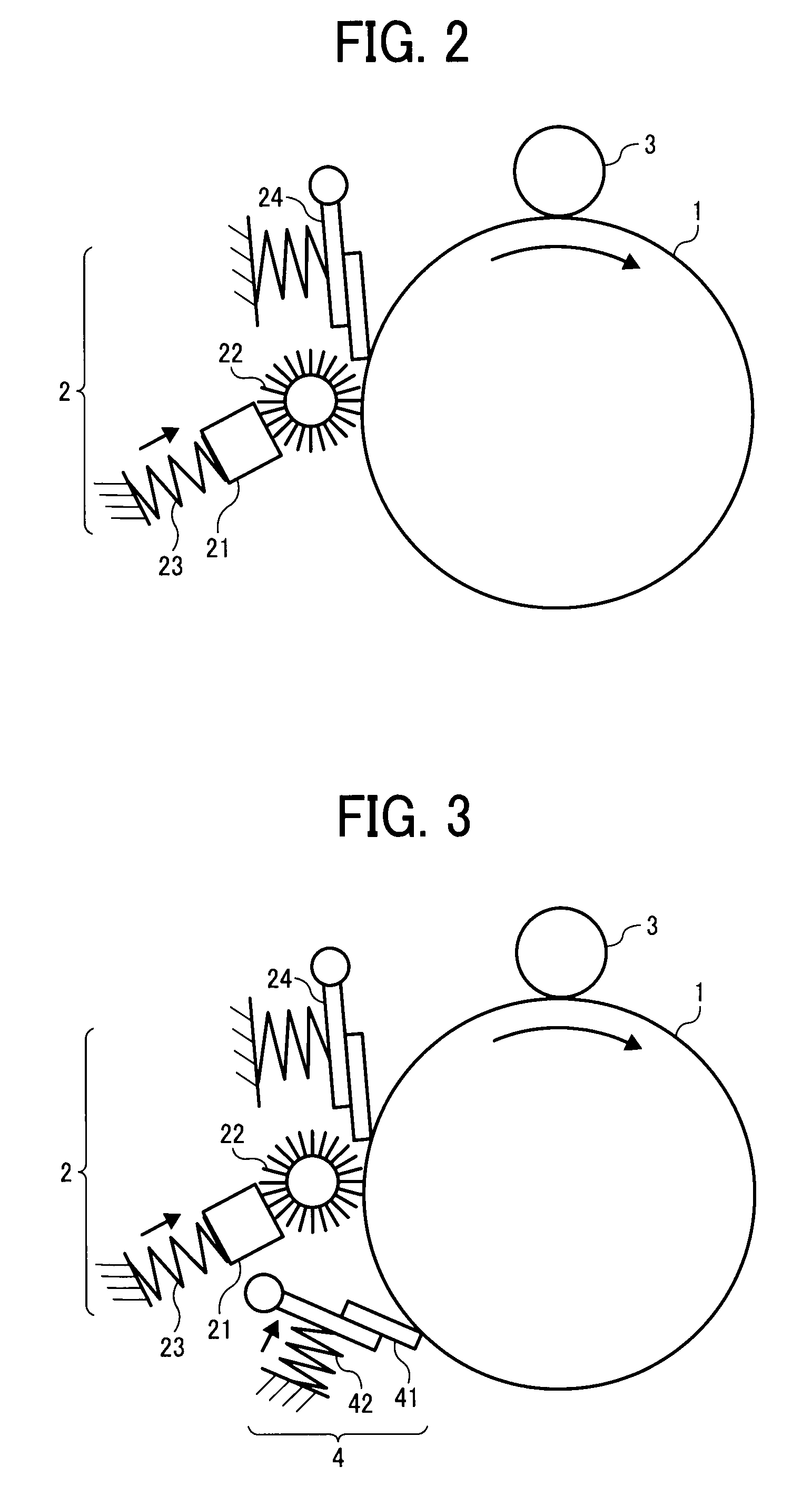Protective material and image forming apparatus using the protective material
a technology of protective materials and image forming apparatus, which is applied in the direction of carpet cleaners, instruments, vehicles, etc., can solve the problems of deterioration of image resolution, shortening of life, and production of poor quality images, and achieves the effect of high resistivity of charging rollers
- Summary
- Abstract
- Description
- Claims
- Application Information
AI Technical Summary
Benefits of technology
Problems solved by technology
Method used
Image
Examples
examples
Protective Material Block 1 (Comparative Example)
[0323]Zinc stearate was heated at 145° C. to be melted in a mold, and cooled to prepare a protective material block 1 having a depth of 40 mm, a width of 8 mm and a length of 350 mm.
Protective Material Block 2 (Example)
[0324]65 parts of stearic acid and 35 parts of palmitic acid were mixed to prepare a mixture. Zinc hydroxide was mixed with the mixture and dried to prepare particles including compatibilized zinc stearate and zinc palmitate and having a diameter of from 25 to 33 μm. The particles were partially dissolved in hydrochloric acid-methanol solution and heated at 80° C. to methylate the stearic acid and the palmitic acid. A ratio of the zinc stearate to the zinc palmitate was measured by gas chromatography. The weight ratio was 64 / 34.
[0325]The particles were placed in a compression mold and an ultrasonic vibration was applied thereto to uniformly disperse them therein. The particles were compressed from above until they have ...
examples 3 to 7
[0349]The image forming apparatus used in Example 1 was modified such that the photoreceptor had a linear speed of 220 mm / sec. 3. A DC voltage of −600 V overlapped with an AC voltage having a frequency of 1.9 kHz and an amplitude of 1.2 kV was applied to the photoreceptor from the charging roller.
[0350]Each four process cartridges using the photoreceptor 2 and the protective material blocks 6 to 11 were prepared and installed in the modified tandem image forming apparatus. Five by five, 30,000 images of a test chart having an image area of 5% were produced totally at 27° C. and 45% RH. Then, halftone yellow, cyan, magenta and black images were produced to evaluate them. The image forming apparatus using the protective material block 6 produced black images on which slight abnormal stripes were observed although acceptable. The image forming apparatus using the protective material blocks 7 to 10 produced high-quality halftone images of all the colors. The image forming apparatus usin...
examples 8 to 10
[0352]The image forming apparatus used in Example 1 was modified such that the photoreceptor had a linear speed of 220 mm / sec. 3. A DC voltage of −600 V overlapped with an AC voltage having a frequency of 1.9 kHz and an amplitude of 1.2 kV was applied to the photoreceptor from the charging roller.
[0353]Each four process cartridges using the photoreceptor 2 and the protective material blocks 12 to 14 were prepared and installed in the modified tandem image forming apparatus. Five by five, 15,000 images of a test chart having an image area of 5% were produced totally at 15° C. and 25% RH. Then, halftone yellow, cyan, magenta and black images were produced to evaluate them. The image forming apparatus using the protective material blocks 12 to 14 produced high-quality halftone images of all the colors.
Photoreceptor 3
[0354]An undercoat coating liquid, a charge generation coating liquid and charge transport coating liquid, which have the following formulations, were coated and dried in t...
PUM
| Property | Measurement | Unit |
|---|---|---|
| area | aaaaa | aaaaa |
| number-average particle diameter Da | aaaaa | aaaaa |
| number-average particle diameter Da | aaaaa | aaaaa |
Abstract
Description
Claims
Application Information
 Login to View More
Login to View More - R&D
- Intellectual Property
- Life Sciences
- Materials
- Tech Scout
- Unparalleled Data Quality
- Higher Quality Content
- 60% Fewer Hallucinations
Browse by: Latest US Patents, China's latest patents, Technical Efficacy Thesaurus, Application Domain, Technology Topic, Popular Technical Reports.
© 2025 PatSnap. All rights reserved.Legal|Privacy policy|Modern Slavery Act Transparency Statement|Sitemap|About US| Contact US: help@patsnap.com



